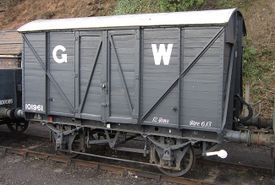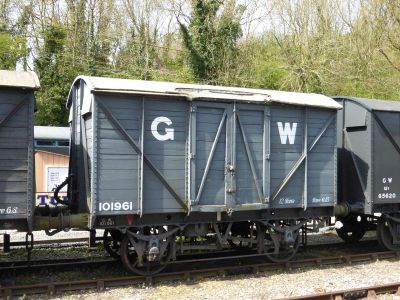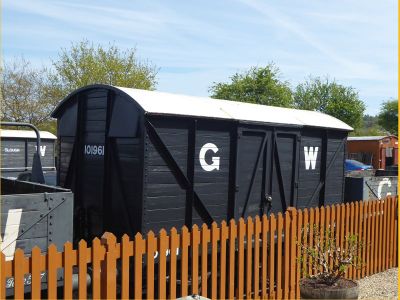Difference between revisions of "GWR 101961 Mink 'A' Covered Goods Van"
m (Update as of date) |
(featured article) |
||
| Line 13: | Line 13: | ||
|telcode = MINK A | |telcode = MINK A | ||
|topscode = | |topscode = | ||
| − | |brakes = | + | |brakes = DC III, Vac-fitted |
|built = 1923 | |built = 1923 | ||
|years1 = 1971 | |years1 = 1971 | ||
| Line 21: | Line 21: | ||
|years3 = | |years3 = | ||
|events3 = | |events3 = | ||
| − | }}101961 | + | }}101961 is a ''''MINK A' 4-wheeled ventilated covered van'''. The GWR [[Telegraph codes|telegraphic code]] 'MINK' refers to a covered van used for transporting merchandise, with the 'A' suffix denoting a ventilated version. |
| − | 101961 arrived on the SVR from Shrewsbury on 6 December 1971. | + | In the earliest days merchandise was carried in open wagons, covered by a tarpaulin if necessary. During the 1860s the GWR began to build covered goods vans with wooden bodies and body frames. Between 1886 and 1901 they were built of iron and became known as an 'IRON MINK'. After that time the GWR reverted to wooden body construction but with iron angle section frames. |
| + | |||
| + | The earliest MINK As, built between 1907 and 1912 to Diagram V12, had a 10-ton capacity with ventilation provided by shutters. However the majority of MINK As, including the five of the six examples resident on the SVR, were built between 1912 and 1927 to either Diagram V14 (vacuum fitted) or Diagram V16 (unfitted). Both types were equipped with DCIII brakes and were the standard 16ft length over the headstocks with a 9ft wheelbase, the ventilation being provided by two bonnets at each end of the van. Those built up to 1923 had a 10-ton capacity, of which 1,624 were to Diagram V14 and 2,260 to Diagram V16. Although the Diagram numbers and wagon dimensions remained unchanged, those built between 1923 and 1927 had a greater 12-ton capacity, requiring an increase in the size of the journals from 8in by 4in to 9in by 5½in.<ref group="note">The ends (or journals) of the axles rotate in bearings inside the axleboxes. The journal length and diameter are larger on vehicles with a higher Tare/load capacity.</ref> The later examples comprised 2,186 to Diagram V14 but only 699 to Diagram V16.<ref name=Atkins>[[Bibliography#Other References|Atkins, Beard & Tourret (2013)]] pp. 33-34, 379.</ref> | ||
| + | |||
| + | The SVR is home to six MINK As. [[GWR 93016 Mink 'A' Covered Goods Van |93016]], [[GWR 93045 Mink 'A' Covered Goods Van|93045]] and [[GWR 95353 Mink 'A' Covered Goods Van|95353]] are all of the earlier Diagram V16 10-ton unfitted type, while 101961 and [[GWR 103592 Mink 'A' Covered Goods Van|103592]] are later examples Diagram V14 12-ton fitted type. [[GWR 104621 Mink 'A' Covered Goods Van|104621]] is also a later 12-ton fitted example, but built to Diagram V18 which incorporated Morton brake gear instead of DCIII. | ||
| + | |||
| + | ==Service and preservation== | ||
| + | GWR 101961 was built at Swindon in 1923 to Diagram V14, Lot 896.<ref name=Atkins/> It was later transferred into Departmental use as a packing van at BR's Wolverton works, numbered DW 150066. For this purpose, the buffer lengths were increased by placing wooden spacers behind the self-contained buffers, to enable it to run with screw coupled vehicles.<ref name=SVR119>SVR News 119, 123</ref> | ||
| + | |||
| + | 101961 arrived on the SVR from Shrewsbury on 6 December 1971, having been acquired by SVR member Jim McNally. It spent the next 25 years in the [[Rock Siding]] at [[Bewdley]] where it was used as a stores van for his locomotive, 0-4-0ST [[Peckett 1738]],<ref name=SVR119/> which had been resident on the SVR since July 1968. | ||
| + | |||
| + | 101961 was acquired by [[The GWR 813 Preservation Fund]] in 1989.<ref>GWR813.org</ref> The Peckett left the SVR circa November 1995. With the van cleared of Peckett parts, restoration by the [[Wagon Department]] at Bewdley finally began in summer 1996. The first task was to refit the brake gear which had been removed during its use as a storage van in an attempt to render it immobile. The buffer spacers were removed and the wagon was fitted with 'instanter' couplings at both ends. The other restoration work required was relatively straightforward, consisting of replacement of the roof canvas and door lintels, door repairs and repainting from its faded Departmental red livery. However at the time the Wagon Group were also heavily involved in trying to repair and improve the [[Bewdley Goods Shed]], resulting in the restoration taking around a year to complete.<ref name=SVR119/> | ||
| + | |||
| + | 101961 received a 'quick repaint' and minor repairs around 2003.<ref>SVR News 147</ref> In 2008 a number of wagons including MOGO 65801 required attention to their roof canvases, and due to a misunderstanding 101961 was shunted in along with 65801. Although no work on 101961's roof was needed, it was found that other repairs were necessary. These included attention to scale on the lower parts of the corner uprights, as a result of which new sections were welded in, and replacement of some of the lower planks. A further repaint was also carried out as the earlier 'quick repaint' had been of a relatively low standard.<ref>SVR News 163, 175</ref> | ||
| + | |||
| + | 101961 then spent some time serving as the Wagon Department's spare timber store as well as appearing in the [[Demonstration Goods Train]]. During a gala appearance in the latter role, the entire 20-year old roof canvas blew off while on the move! After a period of time stored under a sheet, it entered the Goods Shed for attention in 2018. By the end of that year, roof planks had been replaced as necessary and all of the internal timber roof hoops renewed.<ref>SVR News 204, 205</ref> New doors had also been fitted and painting had begun. By October 2019 a new roof canvas had been fitted and reassembly and painting was largely complete.<ref>National Preseervation Forum, "SVR Wagons 2019" thread</ref> However work on the overhaul was then delayed by the [[2020 coronavirus disease (COVID-19) pandemic]] and was just reaching completion in August 2020.<ref>[https://www.svrlive.com/blaug20 Branch Lines, August 2020]</ref> | ||
| + | |||
| + | <gallery mode=packed heights=200px style="text-align:left"> | ||
| + | GWR_101961_20160504.jpg|101961 in the goods train at Highley in May 2016. The roof canvas shows signs of the forthcoming problems | ||
| + | </gallery> | ||
| + | |||
| + | Wagons used in the Demonstration Goods Train are normally based at Bewdley, often in the siding between the Goods Shed and the running lines. However in April 2022 the [[DMU]] was moved to that location, with a number of the wagons including the completed 101961 being moved to the yard at Arley. | ||
| + | |||
| + | <gallery mode=packed heights=200px style="text-align:left"> | ||
| + | GWR_101961_20220430.jpg | 101961 in Arley yard, April 2022 | ||
| + | </gallery> | ||
==See also== | ==See also== | ||
| − | [[Goods Wagons | List of goods wagons]] | + | *[[Goods Wagons | List of goods wagons]] |
| − | [[Rolling stock currently under restoration]] | + | *[[Rolling stock currently under restoration]] |
| + | |||
| + | ==Notes== | ||
| + | <references group="note"/> | ||
==References== | ==References== | ||
| Line 33: | Line 61: | ||
==Links== | ==Links== | ||
| − | *[http://www.gwr813.org/ | + | *[http://www.gwr813.org/101961.html 101961 on www.gwr813.org] |
*[http://www.ws.rhrp.org.uk/ws/WagonInfo.asp?Ref=9658 101961 on Railway Heritage Register On-Line] | *[http://www.ws.rhrp.org.uk/ws/WagonInfo.asp?Ref=9658 101961 on Railway Heritage Register On-Line] | ||
[[Category: Rolling stock owned by The GWR 813 Preservation Fund]] | [[Category: Rolling stock owned by The GWR 813 Preservation Fund]] | ||
| − | [[Category: | + | [[Category:Featured articles]] |
Latest revision as of 14:18, 2 May 2022
| GWRGreat Western Railway 101961 MinkGWR telegraphic code signifying a covered goods van 'A' Covered Goods Van | |
|---|---|
 GWRGreat Western Railway 101961 MinkGWR telegraphic code signifying a covered goods van 'A' Covered Goods Van | |
| Built By | GWRGreat Western Railway Swindon |
| Status | Overhaul |
| Number | 101961 |
| Other Numbers | DW 150066 |
| History | |
| Built | 1923 |
| Diagram | V14 |
| Lot | 896 |
| Type | 4-w ventilated van |
| Capacity | 12 tons |
| Telegraphic code | MINK A |
| Brakes | DC III, Vac-fitted |
| 1971 | Arrived on SVRSevern Valley Railway |
In the earliest days merchandise was carried in open wagons, covered by a tarpaulin if necessary. During the 1860s the GWRGreat Western Railway began to build covered goods vans with wooden bodies and body frames. Between 1886 and 1901 they were built of iron and became known as an 'IRON MINK'. After that time the GWRGreat Western Railway reverted to wooden body construction but with iron angle section frames.
The earliest MINK As, built between 1907 and 1912 to Diagram V12, had a 10-ton capacity with ventilation provided by shutters. However the majority of MINK As, including the five of the six examples resident on the SVRSevern Valley Railway, were built between 1912 and 1927 to either Diagram V14 (vacuum fitted) or Diagram V16 (unfitted). Both types were equipped with DCIII brakes and were the standard 16ft length over the headstocksThe underframe member across each end of a wagon carrying the buffers and coupling. Known as the Bufferbeam on a locomotive. with a 9ft wheelbase, the ventilation being provided by two bonnets at each end of the van. Those built up to 1923 had a 10-ton capacity, of which 1,624 were to Diagram V14 and 2,260 to Diagram V16. Although the Diagram numbers and wagon dimensions remained unchanged, those built between 1923 and 1927 had a greater 12-ton capacity, requiring an increase in the size of the journals from 8in by 4in to 9in by 5½in.[note 1] The later examples comprised 2,186 to Diagram V14 but only 699 to Diagram V16.[1]
The SVRSevern Valley Railway is home to six MINK As. 93016, 93045 and 95353 are all of the earlier Diagram V16 10-ton unfitted type, while 101961 and 103592 are later examples Diagram V14 12-ton fitted type. 104621 is also a later 12-ton fitted example, but built to Diagram V18 which incorporated MortonA type of brakes used on GWR wagons after Grouping in 1923, replacing the earlier DC (Dean Churchward) types. brake gear instead of DCIII.
Service and preservation
GWRGreat Western Railway 101961 was built at Swindon in 1923 to Diagram V14, Lot 896.[1] It was later transferred into DepartmentalRolling stock used for the railway’s own functions (engineering etc.) rather than for general passenger or goods traffic. use as a packing van at BRBritish Rail or British Railways's Wolverton works, numbered DW 150066. For this purpose, the buffer lengths were increased by placing wooden spacers behind the self-contained buffers, to enable it to run with screw coupled vehicles.[2]
101961 arrived on the SVRSevern Valley Railway from Shrewsbury on 6 December 1971, having been acquired by SVRSevern Valley Railway member Jim McNally. It spent the next 25 years in the Rock Siding at Bewdley where it was used as a stores van for his locomotive, 0-4-0ST Peckett 1738,[2] which had been resident on the SVRSevern Valley Railway since July 1968.
101961 was acquired by The GWR 813 Preservation Fund in 1989.[3] The Peckett left the SVRSevern Valley Railway circa November 1995. With the van cleared of Peckett parts, restoration by the Wagon Department at Bewdley finally began in summer 1996. The first task was to refit the brake gear which had been removed during its use as a storage van in an attempt to render it immobile. The buffer spacers were removed and the wagon was fitted with 'instanter' couplings at both ends. The other restoration work required was relatively straightforward, consisting of replacement of the roof canvas and door lintels, door repairs and repainting from its faded DepartmentalRolling stock used for the railway’s own functions (engineering etc.) rather than for general passenger or goods traffic. red livery. However at the time the Wagon Group were also heavily involved in trying to repair and improve the Bewdley Goods Shed, resulting in the restoration taking around a year to complete.[2]
101961 received a 'quick repaint' and minor repairs around 2003.[4] In 2008 a number of wagons including MOGO 65801 required attention to their roof canvases, and due to a misunderstanding 101961 was shunted in along with 65801. Although no work on 101961's roof was needed, it was found that other repairs were necessary. These included attention to scale on the lower parts of the corner uprights, as a result of which new sections were welded in, and replacement of some of the lower planks. A further repaint was also carried out as the earlier 'quick repaint' had been of a relatively low standard.[5]
101961 then spent some time serving as the Wagon Department's spare timber store as well as appearing in the Demonstration Goods Train. During a gala appearance in the latter role, the entire 20-year old roof canvas blew off while on the move! After a period of time stored under a sheet, it entered the Goods Shed for attention in 2018. By the end of that year, roof planks had been replaced as necessary and all of the internal timber roof hoops renewed.[6] New doors had also been fitted and painting had begun. By October 2019 a new roof canvas had been fitted and reassembly and painting was largely complete.[7] However work on the overhaul was then delayed by the 2020 coronavirus disease (COVID-19) pandemic and was just reaching completion in August 2020.[8]
Wagons used in the Demonstration Goods Train are normally based at Bewdley, often in the siding between the Goods Shed and the running lines. However in April 2022 the DMU was moved to that location, with a number of the wagons including the completed 101961 being moved to the yard at Arley.
See also
Notes
- ↑ The ends (or journals) of the axles rotate in bearings inside the axleboxes. The journal length and diameter are larger on vehicles with a higher Tare/load capacity.
References
- ↑ 1.0 1.1 Atkins, Beard & Tourret (2013) pp. 33-34, 379.
- ↑ 2.0 2.1 2.2 SVRSevern Valley Railway News 119, 123
- ↑ GWR813.org
- ↑ SVRSevern Valley Railway News 147
- ↑ SVRSevern Valley Railway News 163, 175
- ↑ SVRSevern Valley Railway News 204, 205
- ↑ National Preseervation Forum, "SVRSevern Valley Railway Wagons 2019" thread
- ↑ Branch Lines, August 2020

